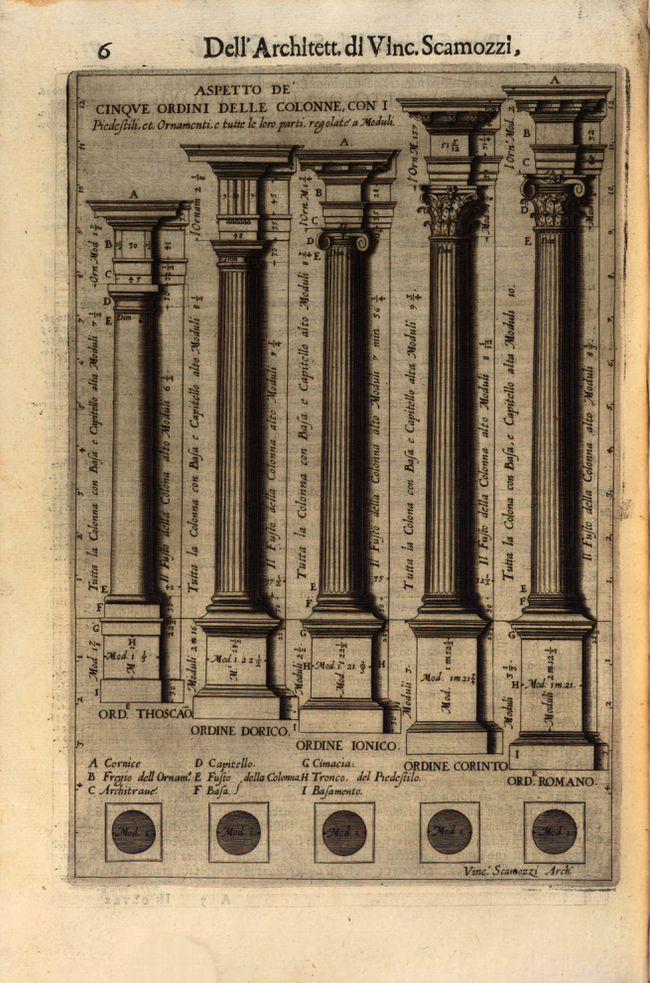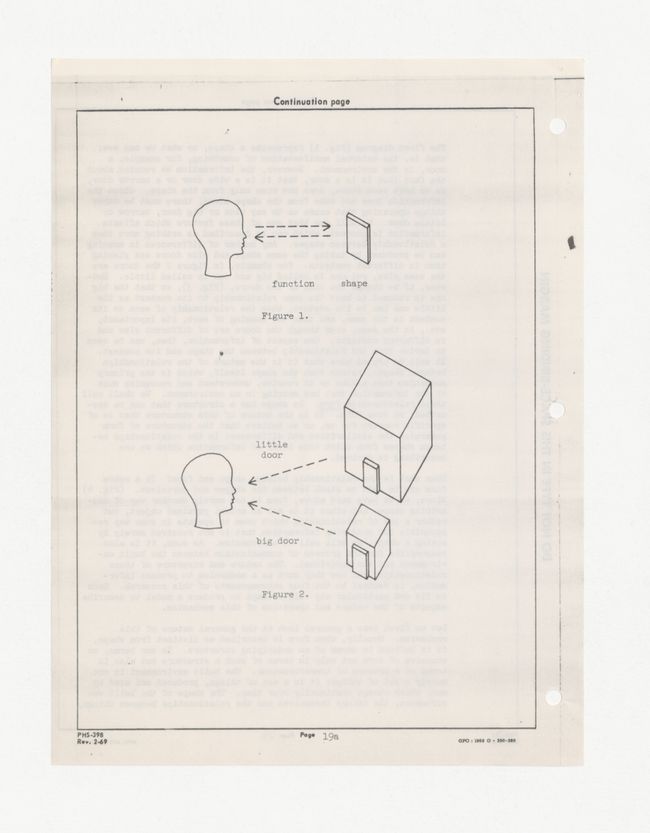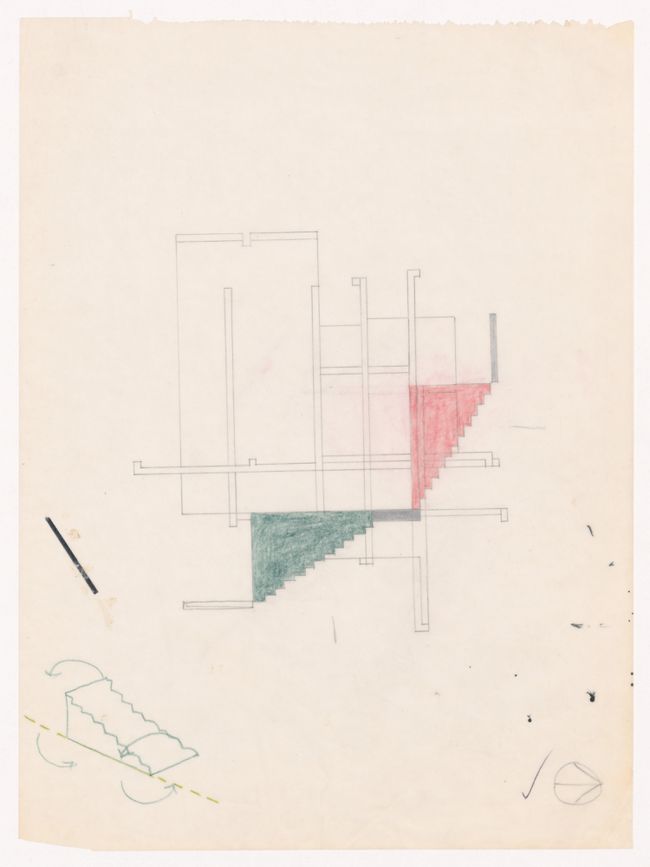In Suspicion of Theory
Dijana O. Apostolski, Jana Berankova, Amir Taheri, Vitório Leite
This is the second instalment of “In Suspicion of…”, a series of skeptical readings of the elastic intersections between law and the built environment, authored by the participants in the 2021 Toolkit for Today seminar on the theme of Legalities for Living and introduced by Shivani Shedde. Dijana O. Apostoloski interrogates how ideal bodies informed the proportions of early modern ornament, Jana Ndiaye Berankova analyzes the polarizing status of linguistics in 1970s architectural discourse, Amir Taheri considers Peter Eisenman’s applied use of semiotics in his early housing experiments, and Vitório Leite explores how the concept of indeterminacy shapes community engagement and user-driven approaches to design. Each author casts theory in doubt to explore how architectural form generates—or restricts—meaning and access.
In Suspicion of Hercules’s Foot
Dijana O. Apostolski
In the second part of his L’idea dell’architettura universale (1615), early modern architect and theorist Vincenzo Scamozzi (1548–1616) argued for the essential use of the architectural module in design practice. He claimed that architecture must follow the archetypes and measurements established by “Nature” as standards for every genus, species, kind, or race. Scamozzi singled out Hercules’s body and his foot, which Pythagoras apparently had calculated, as the uniform standard measurement to regulate the proportions of “true architecture” against divergent bodies and norms.1 According to the architect, Hercules’s foot and height-to-foot ratio established the “correct” proportions of a column’s base and its height-to-base ratio, the overall proportion of the classical orders, and the proportions of universal architecture. Appealing to architecture’s innate necessity to follow Hercules’s ideal measurements, Scamozzi demanded: “Why doesn’t reason use its weights and measures to govern concrete things in the way that penalties curb offenses?”2
What can Scamozzi’s exaltation of Hercules’s foot tell us about how normative measurements based on ideal bodies determine control and jurisdiction in architecture? Scamozzi developed his theory of architecture based on the authority of “wise men” such as Pythagoras to justify provisional rules and hierarchies as absolute and universal. In addition, he noted that the ancient Roman armies that “conquered every nation” contributed to the “natural sieving” of the five orders by examining foreign ornament before destroying seized buildings.3 Building upon the claims of “wise men,” imperialistic narratives, and cultural beliefs about “Nature,” Scamozzi tailored architectural knowledge in restrictive Italocentric terms.
In doing so, Scamozzi also essentialized the power dynamics of early modern patronage. He, like many architectural theorists of his time, held that the architectural order of a building—the type of columnar form used—should match the function of the edifice and elevate the patron’s status. For example, he argued that the Roman order was suitable for princely palaces and palaces built as memorials to singular people, acts, and families of “noble blood.” In comparison, the palaces’ quarters assigned to the workers and enslaved people should not be ornamented at all.4 Following ancient philosopher and historian Strabo’s counsel, he explained how “the caverns of the troglodytes in Ethiopia” do not have any ornaments of any kind.5 By associating architectural orders with corporeal genera, Scamozzi’s theories facilitated the codification of forms, as well as the othering, and segregation of classes and bodies in early modern public and private realms. The offenses he wished to restrict seem to have referred to unconventional and dissenting design decisions that threatened to disturb the conservative and stratified milieu in which he aimed to ascend. Just like Hercules’s foot, Scamozzi’s theory was self-serving, forceful, and commanding.
Scamozzi’s manner of constructing theory based on the authority of “wise men” endures in principle and practice, persisting through commentaries such as this “suspicious” reading. Criticizing suspicious readings, Eve Kosofsky Sedgwick termed the specialist’s authority a “hypervigilance of knowing” that safeguards normative histories and institutional expertise. According to Sedgwick, “the methodological centrality of suspicion” is reflexive and mimics the strong theory model.6 Instead of reading suspiciously to question the authority of “wise men,” Sedgwick offered the model of “weak theory.” “Weak theory,” according to Sedgwick, is an inquisitive theoretical framework to follow the questions posed by the object of inquiry more attentively. Unlike strong theory, weak theory is affective, descriptive, and does not offer “hard truths.” Scamozzi’s strong theory demonstrates how early modern architectural exclusion operated through normative anthropomorphic references and universalizing notions of truth. Moving away from tracts and treatises to respond to other forms of architectural evidence, we might build “weak theories” around the atypical, unornamented, overornamented, and vernacular forms that speak more closely to the bodies, limbs, and feet that designed, built, and occupied them.
-
Vincenzo Scamozzi, L’idea dell’architettura universale…divisa in X libri, Lib. Sesto, Cap. II (Venice: Expensis auctoris, 1615), 4; translated in Vincenzo Scamozzi, Vincenzo Scamozzi, Venetian Architect: The Idea of a Universal Architecture, Book VI: The Architectural Orders and Their Application, trans. Patti Garvin, Koen Ottenheym, and Wolbert Vroom (Amsterdam: Architectura & Natura Press, 2008), 55. ↩
-
Scamozzi, L’idea dell’architettura universale, 4, translated in Scamozzi, Venetian Architect,55. ↩
-
Scamozzi, L’idea dell’architettura universale, 30, translated in Scamozzi, Venetian Architect, 113. ↩
-
Scamozzi, L’idea della architettura universale, 104-105, translated in Scamozzi, Venetian Architect, 241. ↩
-
Scamozzi, L’idea della architettura universale, 15, translated in Scamozzi, Venetian Architect, 76. ↩
-
Eve Kosofsky Sedgwick and Adam Frank, “Paranoid Reading and Reparative Reading,” Touching Feeling: Affect, Pedagogy, Performativity (Durham: Duke University Press, 2003), 125. ↩
In Suspicion of Linguistics
Jana Berankova
Institute for Architecture and Urban Studies, Diagram on p. 19a of Grant application for Program in Generative Design to the National Institute of Mental Health (NIMH) Department of Health, Education, and Welfare, 15 January 1973. Reprographic copy. ARCH401304. Institute for Architecture and Urban Studies fonds, CCA. © CCA
In 1971, Diana Agrest and Mario Gandelsonas worked with Peter Eisenman and Duarte Cabral de Mello on a research project titled “The Program in Generative Design.” This project received an important grant from the National Institute of Mental Health, which helped to secure financing of the Institute for Architecture and Urban Studies in New York City.1 In the grant application, the authors, influenced by structuralism and semiotics, proposed examining the mechanisms by which architectural forms acquire meaning and how they act as signs. Using intricate diagrams and terminology rooted in linguistics, they aimed to develop four models for how the built environment generates behaviors and forms that communicate meaning, which changes and transforms based on socio-historical contexts and coded references.
However, a close reading of this text reveals a clear dissonance between Eisenman’s and the other three contributors’ theoretical understanding of the relation between architectural form and meaning.2 The title of this collaborative project directly alludes to Eisenman’s interest in philosopher Noam Chomsky, who advanced the controversial theory of “generative grammar,” according to which linguistic variation is generated from an innate and universal set of grammatical rules. In contrast to Eisenman’s understanding of architectural form as independently generating transformations and variations of meaning, Agrest, Gandelsonas, and Cabral de Mello held that form is “merely a mechanism, a device for change and not the generator of it,” thus its meaning cannot be considered independently of the social, cultural, and political contexts of design.3
The research project is a sort of a chiasmus of perspectives rather than a coherent theoretical document, combining two competing theoretical orientations: on the one hand, Eisenman’s interest in pure and supposedly “universal” geometrical forms that exist “independent of history,” and Agrest, Gandelsonas, and Cabral de Mello’s belief in the social conditioning on the other.4 In 1972, Gandelsonas published an article “On Reading Architecture,” in which he approached Eisenman’s work according to what philosopher Louis Althusser referred to as “Generality I”: a pre-existent ideological schema which only produces a significant and productive object of theoretical analysis when critiqued (“Generality III”).5 In a way, Gandelsonas suggested that a rigorous, conscious, and informed interpretation could result by placing an initial “abstract object”—Eisenman’s work and thought—under suspicion.
Following the supposed “end of theory” and the post-critical turn at the start of the millennium, linguistics has fallen out of favour in architectural thinking in preference of more sociocultural approaches. However, perhaps if we follow Gandelsonas’ suspicious approach, we could generate new interpretive methods by casting doubt on the standard terms and doxa of architectural discourse, revisiting tired debates and “outdated” theories, and rethinking the increasingly tangled relationship between form and meaning anew.
-
In 1972, Agrest, Gandelsonas, Eisenman, and Cabral de Mello’s project received a two-year grant subsidy from the National Institute of Mental Health (NIMH), which was not renewed. See “Program in Generative Design,” (1970), 73, AP057.S2.SS6, CCA. ↩
-
Gandelsonas sees the apolitical nature of Eisenman’s work as the main deficiency of his project. He also briefly criticized Eisenman’s “suppression of the political and of the social” in his essay “Not the Last Word” (1993). See Mario Gandelsonas, “Not the Last Word,” Any, no. 1 (1993): 62. ↩
-
Diana Agrest, Mario Gandelsonas, Peter Eisenman, Duarte Cabral, “Program in Generative Design, Grant Application,” (1973), 23, ARCH.401304, CCA. ↩
-
Agrest et. al., “Program in Generative Design, Grant Application,” 27. ↩
-
Mario Gandelsonas, “On Reading Architecture,” Progressive Architecture, no. 3 (March 1972): 68–87. ↩
In Suspicion of the Sign
Amir Taheri
On the back of the linguistic turn dominating critical theory and influencing architectural discourse in the 1960s and 1970s, Peter Eisenman attempted to bridge the philosophy of perception and semiotics in his early work, translating the theoretical realm of linguistic signs into the physical reality of the built environment. Engaging with the idea of the unmotivated sign, particularly in his text “The Diagram and the Becoming Unmotivated of the Sign,” Eisenman proposed new frameworks for a conceptual practice in architecture that questioned standards of authorship, meaning, and representation.1 He begins this text with a suspicious account of Charles Sanders Peirce’s conceptualization of the linguistic sign in architectural terms. In his semiotics, Peirce defined three categories of the sign: the icon, the symbol, and the index. In his terms, icons and symbols have no direct link—or motivation—between the sign and what it signifies. On the other hand, indexical signs are motivated, in that the sign is not arbitrary but remains somehow connected in some way, physically or causally, to the concept it signifies.
Eisenman conceived of the possibility of the unmotivated indexical sign as potentially opening up new ways of creating and reading architectural space. As Eisenman puts it, because of architecture’s physicality, in built form, the sign and the signified operate as the same thing, unified by their very real presence. That is, architectural signs are inherently motivated: the form of a given structure (like a staircase) directly corresponds to a built object, rather than to a symbolic or abstract concept. We might understand this tangibility the inherently self-referential condition of built architecture.2 In other words, the physical presentness of built forms shut down the interpretation of their meaning—the form of a staircase can only refer to a staircase.
To expose the arbitrary nature of signification, Eisenman relied on the diagram to introduce what he called an “internal motivation” into the design of his early houses, employing generative diagrams that are purely self-referential and hence purely formal.3 In figure 1, Eisenman tries to determine the composition for vertical circulation in house VI (Cornwall, Connecticut, 1972-1975). An upside-down staircase rendered in red crystallizes the theoretical operation of conceptual architecture. Eisenman places it in contrast and opposition to the functional staircase rendered in green. The red upside-down staircase explicitly lacks a practical, and hence perceptual, purpose; it is a formal entity through which Eisenman “unmotivates” the architectural sign of the staircase, liberating its representation from signifying an act of vertical circulation. In such a case, he arrives at what architect and critic Silvio Cassarà terms a chronicle of an “unexpected” architecture—an architecture that is virtual in the sense that it embodies a memory of its past condition, projected as a formal trace of a deliberately misplaced and decontextualized idea.4
In putting the architectural sign under suspicion in his early works, Eisenman proposed unconventional strategies of reading, interpreting, and writing in and about architecture and its representation. Through the diagram, Eisenman advanced the “unmotivated” architectural sign as one no longer defined by perceptual function and utilitarian purpose, or even geometric order and composition. In his terms, it is a kind of indexical sign that aims to produce objects that have more to do with purely formal and spatial relationships, superpositions, and, in his own words, “misreading(s)” of architectural space.5
-
Peter Eisenman, “The Diagrams and the Becoming Unmotivated of the Sign,” in The Diagrams of Architecture, ed. Mark Garcia (Chichester: Wiley, 2010), 207. ↩
-
A similar notion to this concept of self-referentiality in architecture is discussed in Markus Breitschmid and Valerio Olgiati, Non-Referential Architecture(Zurich: Park Books, 2019), 79. ↩
-
Peter Eisenman, Diagram Diaries (New York: Universe Publishing, 1999) 27-35. ↩
-
Silvio Cassarà, Peter Eisenman Feints (Milan: Skira, 2006), 9. ↩
-
Peter Eisenman, “Misreading Peter Eisenman,” in Written into the Void: Selected Writings 1990-2004, (New Haven and London: Yale University Press, 2004), 208-225. ↩
In Suspicion of Determinacy
Vitório Leite
On February of 1972, James Stirling sent a letter to Peter Land in which he included drawings and engineering notes for the PREVI [Proyecto Experimental de Vivienda] Lima housing pilot project.1 In this short statement, Stirling requested that certain parts of the dwellings should be constructed in a “more naturalistic way” to appear self-built, for example by incorporating rough brick and concrete features to contrast with the finely-detailed features of the initial design phase.2 Like most of the other projects from the same pilot housing project, the final design was fixed in advance; indeterminacy, or an openness to changes and adaptations of the construction, was planned for and desired by the projects’ architects.
The PREVI program evidenced a shifting disciplinary interest in more open ways to build human habitats. In the 1960s and the early 1970s, some architects and planners such as Aldo Van Eyck, Fumihiko Maki, or Christopher Alexander, reformed modern design methods premised on rationality, program functionality, and optimizing physical health. These architects considered how diverse subjectivities experienced the built environment and promoted a more inclusive, contingent, and adaptative way of planning and designing. Simultaneously, countercultural movements were preoccupied with what semiotician Umberto Eco conceptualized as the poetics of indeterminacy, opening political, artistic, scientific, and architectural practices to a wider range of critiques and including public participation of these processes.4 Eco envisioned this cultural shift as one of the most radical and humanistic changes of his time, in that it encouraged the intervention of users and spectators in the production of meaning, which he believed transformed static artistic, scientific, and architectural into more dynamic experiences.
The suspicions that the architects of PREVI demonstrated toward determinacy in design led to more economically-viable and socially responsive architectural practices. In the 1970s, these architects advanced novel design processes operating before and beyond legal frameworks and standard architectural methodologies. Now, their legacy supports the practices of architects who are trying to engender more participatory tools and inclusive mechanisms for the transformation of socio-spatial realities.
-
PREVI Lima is a housing program developed from 1965 to 1973 by the Peruvian government and the United Nations to overcome the severe housing shortage of the country. James Stirling was one of the architects invited to participate in the project. Peter Land was consultant for the Peruvian Government and project manager of PREVI. ↩
-
James Stirling, “Letter from James Stirling to Peter Land,” (1 February 1972). AP140.S2.SS1.D35.P6, CCA. ↩
-
John F.C. Turner, “Preface,” in ¡El Tiempo Construye! El Proyecto Experimental de Vivienda (PREVI) de Lima: génesis y desenlace, ed. Fernando Garcia-Huidobro, Diego Torriti, and Nicolás Tugas (Barcelona: Editorial Gustavo Gili, SL, 2008) ↩
-
Umberto Eco, Obra aberta, trans. João R. N. Furtado (Lisbon: Relógio d’Água, 2016 [1962]). ↩



